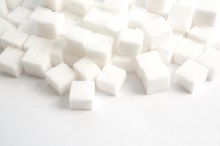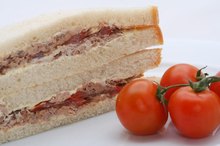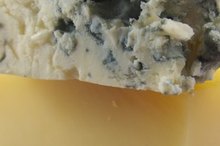Fructose Vs. Sucrose
Fructose and sucrose both fall under the designation of sugars. Biochemically, they're both carbohydrates -- fructose is a monosaccharide and sucrose is a disaccharide, meaning that fructose is made of a single sugar unit, while sucrose is made of two sugar units. Both taste sweet, and both are common in food substances.
Fructose Chemistry
Fructose is often called fruit sugar, because one of the most common sources of pure fructose in the human diet is fruit. The chemical structure of fructose is slightly different than that of many other common dietary monosaccharides. Unlike most other sugar units, which consist of a central ring of five carbon atoms and one oxygen, fructose consists of a central ring of four carbon atoms and one oxygen. The remaining atoms form arms off the central ring.
Sucrose Chemistry
Sucrose, Dextrose & Maltodextrin
Learn More
Sucrose is a disaccharide, so it consists of two sugar units chemically linked together, explain Drs. Reginald Garrett and Charles Grisham in their book "Biochemistry." Specifically, sucrose consists of a fructose molecule bonded to a glucose molecule. Sucrose is commonly called table sugar, and while there are sources of sucrose in food -- it occurs naturally in fruit, for instance -- it's most common as a food additive.
Energy Content
Both fructose and sucrose contain 4 calories per gram. This energy content is actually common to all carbohydrates -- including starches, which are chemically related to sugars, but don't taste sweet. Because fructose tastes much sweeter than sucrose, it's possible to obtain a similar sweetness effect from fewer grams, and fewer calories,f of fructose than of sucrose. For this reason, fructose is sometimes called a lower-calorie sweetener.
Digestion and Absorption
Three Types of Sugars
Learn More
When you eat food that contains fructose, you don't need to digest the fructose before your intestine can absorb it, explains Dr. Lauralee Sherwood in her book "Human Physiology." The intestines can absorb monosaccharides, but can't absorb disaccharides or larger carbohydrates. You digest sucrose into monosaccharides -- fructose and glucose -- using a digestive enzyme called sucrase. This enzyme occurs in the intestine, and allows you to absorb the monosaccharides from sources of sucrose.
Cellular Use
Your cells use sucrose similar to how they use fructose -- particularly because sucrose contains 50 percent fructose. Cells can burn fructose for energy, or can convert it to fat and store it. One difference between sucrose and fructose, explain Drs. Mary Campbell and Shawn Farrell in their book "Biochemistry," is that sucrose contains glucose. This means sucrose triggers insulin release. Insulin is a hormone that the pancreas releases that tells cells to take up glucose from the blood. Fructose consumption triggers a much less significant insulin release.
Related Articles
References
- Biochemistry; Reginald Garrett, Ph.D., et al.
- Human Physiology; Lauralee Sherwood, Ph.D.
- Biochemistry; Mary Campbell, Ph.D., et al.
Writer Bio
Kirstin Hendrickson is a writer, teacher, coach, athlete and author of the textbook "Chemistry In The World." She's been teaching and writing about health, wellness and nutrition for more than 10 years. She has a Bachelor of Science in zoology, a Bachelor of Science in psychology, a Master of Science in chemistry and a doctoral degree in bioorganic chemistry.









